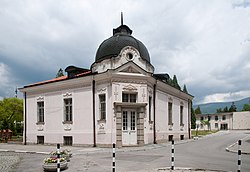Pirdop
Pirdop
Пирдоп | |
|---|---|
 A bank building in Pirdop | |
| Coordinates: 42°42′N 24°11′E / 42.700°N 24.183°E | |
| Country | Bulgaria |
| Provinces (Oblast) | Sofia |
| Government | |
| • Mayor | Angel Gerov |
| Elevation | 696 m (2,283 ft) |
| Population (2024[1]) | |
• Total | 6 611 |
| Time zone | UTC+2 (EET) |
| • Summer (DST) | UTC+3 (EEST) |
| Postal Code | 2070 |
| Area code | 07181 |
Pirdop (Bulgarian: Пирдоп [pirˈdɔp]) is a town located in central-west Bulgaria. As of 2024, it had a population of 6,739.[1] Pirdop Gate on Livingston Island in the South Shetland Islands, Antarctica is named after Pirdop.[2]
Geography
[edit]
The town is situated in the Zlatitsa–Pirdop Valley, the highest of the eleven Sub-Balkan valleys at an altitude of 670 m. It is surrounded by the Balkan Mountains to the north, the Sredna Gora mountain range to the south, and Koznitsa and Galabets saddles to the east and west, respectively. Several small tributaries of the river Topolnitsa run through the town.[3][4]
Pirdop falls within the temperate continental climatic zone with cold influence from the Danubian Plain penetrating through the Zlatitsa Pass from the north and subtropical influence from the Topolnitsa valley from the south. The average annual temperature is 9.4 °C. The annual precipitation reaches 590 mm, with a maximum in June (97 mm) and a minimum in February (26 mm). Snow cover lasts for about 48 days. The soils are cinnamon forest soils.[5]
Administratively, the town is the seat of the Pirdop Municipality, located in the eastern part of Sofia Province. Pirdop is served by the first class I-6 road Gyueshevo–Sofia–Karlovo–Burgas and railway line No. 3 Iliyantsi (Sofia)–Karlovo–Sliven–Karnobat–Varna operated by the Bulgarian State Railways.[5][6]
History
[edit]
The area of Pirdop was populated since Antiquity by the Thracians. It was later conquered by the Romans and eventually became part of the Byzantine Empire. From that period dates the nearby Elenska Basilica, constructed in the late 5th or early 6th century during the reign of emperor Justinian I. In the Middle Ages it became part of the First and Second Bulgarian Empire. The medieval Bulgarian Pirdop Apostle was discovered in a monastery near the town. It was eventually conquered by the Ottomans during the Bulgarian–Ottoman wars in the 14th century. The settlement was mentioned in Ottoman registers of 1430 as Protopopintsi. The name Pirdop was attested for the first time in 1727 in a book in the Glozhene Monastery.[5][7]
During the Bulgarian National Revival in the 19th century Pirdop became a major economic center. Over 700 workshops produced braid; other local crafts included carpet weaving, cloth making, shoe-making, and goldsmithing. In economic terms, it competed with important centers of the Bulgarian lands as Gabrovo, Karlovo, Kalofer, Kotel, etc. In 1870, during the struggle for national liberation, the Vasil Levski founded a revolutionary committee in Pirdop. After the Liberation of Bulgaria in 1878, the town was among the few to have four representatives in the Constituent National Assembly. In the period between 1 April 1978 and 31 August 1991 Pirdop was merged with the neighbouring Zlatitsa to form a single town called Srednogorie.[7][8]
Economy
[edit]The main economic activity is non-ferrous metallurgy. The Pirdop copper smelter and refinery is the biggest in the Balkans and whole of Southeastern Europe. It was privatized in 1997 for $80,000,000 and is owned by the German Aurubis. It has a capacity of about 300,000 tons refined copper. The factory also produces 830,000 tons of sulphuric acid and employs about 1,000 workers. The main chimney of the factory is 325 metres tall and shares together with the chimneys of Maritza East Power Stations the title of tallest man-made objects of Bulgaria.[5][9][10]
Gallery
[edit]-
Church of the Assumption
-
Museum of history
-
The railway station
Citations
[edit]- ^ a b "Tables of Persons Registered by Permanent Address and by Current Address". Official Site of the Civil Registration and Administrative Services (GRAO). Retrieved 28 April 2025.
- ^ "Antarctica: Livingston Island and Greenwich, Robert, Snow and Smith Islands. Scale 1:120000 topographic map". Troyan: Manfred Wörner Foundation, 2009. Retrieved 28 April 2025.
- ^ Encyclopaedia Bulgaria, Volume VI 1988, pp. 380–381
- ^ Geographic Dictionary of Bulgaria 1980, pp. 462–463
- ^ a b c d Encyclopaedia Bulgaria, Volume VI 1988, p. 381
- ^ "A Map of the Republican Road Network of Bulgaria". Official Site of the Road Infrastructure Agency. Retrieved 28 April 2025.
- ^ a b "History". Official Site of Pirdop Municipality. Retrieved 28 April 2025.
- ^ "Srednogorie". Retrieved 8 August 2017.
- ^ "Политическа икономия на раздържавяването в България". Retrieved 16 March 2007.
- ^ "Pirdop Aurubis Med". Archived from the original on 8 March 2011. Retrieved 3 January 2007.
References
[edit]- Георгиев (Georgiev), Владимир (Vladimir) (1988). Енциклопедия България. Том VI. С-Ти [Encyclopaedia Bulgaria. Volume VI. S-Ti] (in Bulgarian). и колектив. София (Sofia): Издателство на БАН (Bulgarian Academy of Sciences Press).
- Мичев (Michev), Николай (Nikolay); Михайлов (Mihaylov), Цветко (Tsvetko); Вапцаров (Vaptsarov), Иван (Ivan); Кираджиев (Kiradzhiev), Светлин (Svetlin) (1980). Географски речник на България [Geographic Dictionary of Bulgaria] (in Bulgarian). София (Sofia): Наука и култура (Nauka i kultura).
External links
[edit]- "Official Site of Pirdop Municipality" (in Bulgarian). Retrieved 28 April 2025.






